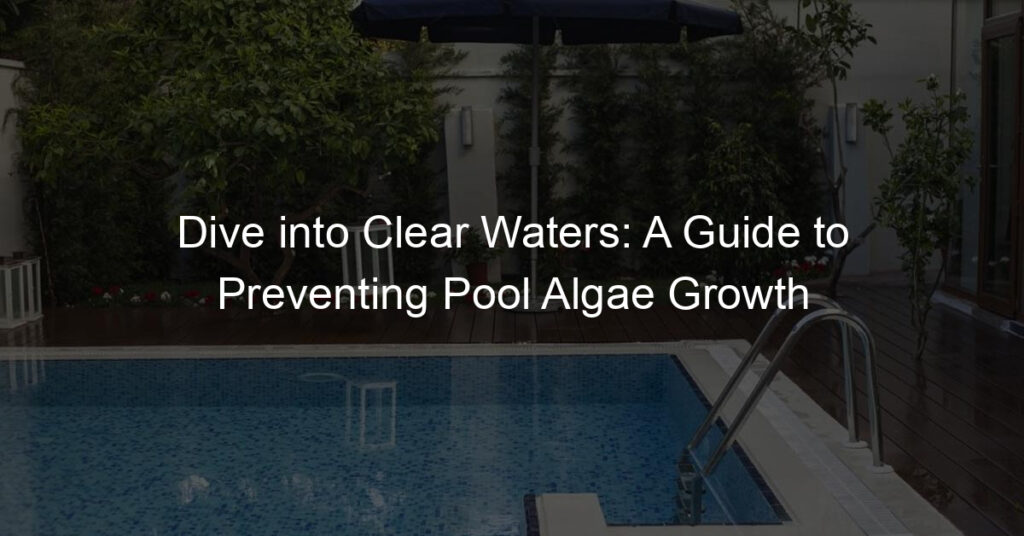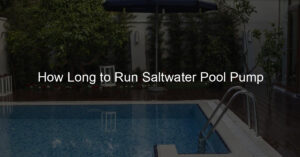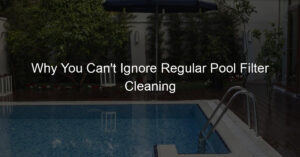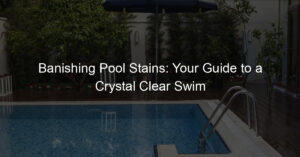Understanding Pool Algae
When it comes to maintaining a clean and healthy swimming pool, understanding pool algae is crucial. Algae are tiny plants that grow in water, including your swimming pool. They can be a nuisance, making your pool look uninviting and causing potential health risks. Let’s dive deeper into what pool algae are, their types, and what causes their growth.
- What is Pool Algae?
- Types of Pool Algae
- Causes of Pool Algae Growth
Pool algae are microscopic plants that thrive in water. They use photosynthesis to grow, just like other plants. When they multiply, they can turn your pool water green, yellow, or even black. Not only do they make your pool look dirty, but they can also cause slippery surfaces, clogged filters, and even health issues like skin irritation.
There are mainly three types of pool algae: green, yellow (also known as mustard algae), and black. Green algae are the most common and can turn your pool water into a murky green color. Yellow algae are less common but are more difficult to eliminate. Black algae are the least common but the most challenging to remove because they form a protective layer that resists most pool cleaning methods.
Pool algae growth can be triggered by several factors. These include poor water circulation, inadequate filtration, imbalanced water chemistry, and lack of routine maintenance. Warm weather and sunlight can also accelerate algae growth. Regular pool cleaning and maintenance can help prevent these unwanted guests from taking over your pool.
In the following sections, we will discuss how to prevent algae growth in pools, provide pool cleaning tips for algae, share some successful algae prevention strategies, and highlight key takeaways for preventing pool algae growth. Stay tuned!
Algae Growth in Pools
Algae growth in pools is a common problem faced by pool owners. It can turn the water green, create a slippery surface, and even cause unpleasant odors. Understanding the factors that contribute to algae growth can help in preventing it.
Factors Contributing to Algae Growth
There are several factors that contribute to the growth of algae in pools. Here are the top three:
- Water Temperature
- Light Exposure
- Chemical Imbalance
Algae thrive in warm temperatures. When the water temperature in your pool rises, it creates a perfect environment for algae to grow. The ideal temperature for most algae species is between 20°C and 30°C (68°F and 86°F).
Algae need light to perform photosynthesis, a process that allows them to grow and reproduce. Pools that receive a lot of sunlight are more prone to algae growth. This is why it’s common to see algae in outdoor pools during the summer months.
Algae can grow rapidly when there’s a chemical imbalance in your pool. This can happen when the pH level is too high or too low, or when there’s not enough chlorine to kill the algae. Regularly testing your pool’s water and adjusting the chemicals as needed can help prevent algae growth.
By understanding these factors, you can take steps to prevent algae growth in your pool. In the next section, we’ll discuss how to identify signs of algae growth and what you can do to prevent it.
Identifying Algae Growth
When it comes to maintaining a clean and healthy pool, it’s crucial to be able to identify the signs of algae growth. Algae can turn your pool into a murky, uninviting environment. But how can you tell if your pool is experiencing algae growth? Let’s explore two main indicators: visible signs and water quality.
- Visible Signs
- Water Quality
One of the most obvious signs of algae growth is a visible change in your pool’s appearance. Algae can cause your pool water to turn green, yellow, or even black. You might also notice a slimy residue on the pool walls or floor. This is actually a buildup of algae. If you see these signs, it’s likely that algae is growing in your pool.
Another indicator of algae growth is a change in water quality. Algae can make your pool water cloudy and can even cause it to smell bad. If you notice that your pool water is not as clear as it usually is, or if it has an unusual odor, this could be a sign of algae growth. Regularly testing your pool water for pH levels and other chemical imbalances can also help you detect algae growth early.
Being able to identify algae growth is the first step in maintaining a clean and healthy pool. Remember, the sooner you can identify and address algae growth, the easier it will be to get your pool back to its sparkling clean state.
How to Prevent Pool Algae
Keeping your swimming pool free from algae is essential for maintaining a healthy and enjoyable swimming environment. Let’s explore some key strategies for preventing pool algae.
Pool Maintenance and Algae
Effective pool maintenance is a crucial part of preventing algae growth. Here are three critical aspects to focus on:
- Regular Cleaning
- Chemical Balancing
- Proper Filtration
Regular cleaning is the first line of defense against algae. This includes skimming the pool’s surface, brushing the walls and floor, and vacuuming. These actions remove debris that could potentially feed algae, keeping your pool clean and clear.
Keeping your pool’s chemical levels balanced is another essential step in preventing algae growth. This includes maintaining the correct levels of pH, alkalinity, and sanitizer. An imbalance in these chemicals can create an environment conducive to algae growth.
Your pool’s filtration system plays a significant role in preventing algae. It removes small debris and contaminants that could feed algae. Running your filter for at least 8-10 hours a day can help keep your pool algae-free.
By focusing on these three aspects of pool maintenance, you can significantly reduce the chances of algae growth in your pool. Remember, prevention is always better than cure when it comes to pool algae.
Algae Control in Swimming Pools
Algae can be a persistent issue in swimming pools, but with the right strategies, you can keep your pool clean and algae-free. Here are three effective methods for algae control:
- Use of Algaecides
- Shock Treatment
- Brushing and Vacuuming
Algaecides are chemicals specifically designed to kill algae. They are a crucial part of pool maintenance. When used correctly, algaecides can effectively eliminate existing algae and prevent new growth. However, it’s important to note that algaecides should be used as a last resort, after all other methods have been tried. Overuse can lead to algae becoming resistant to the chemicals.
Shock treatment, or super chlorination, is a method of adding large amounts of chlorine to the pool to kill algae and other bacteria. This is typically done on a weekly basis, or after a heavy rain or large pool party. Shock treatment is an effective way to kill algae, but it’s important to balance the pool’s chemistry afterwards to ensure the water is safe for swimming.
Regular brushing and vacuuming of the pool can help remove algae before it has a chance to grow. Brushing helps to dislodge algae from the pool walls and floor, while vacuuming removes the dislodged algae from the water. This method is most effective when combined with regular chemical treatments.
Remember, the key to algae control is regular maintenance and monitoring. By staying vigilant and taking action at the first sign of algae, you can keep your pool clean and safe for everyone to enjoy.
Pool Cleaning Tips for Algae
Keeping your pool clean and free of algae is crucial for maintaining a healthy and enjoyable swimming environment. Here are some practical tips to help you effectively clean your pool and prevent algae growth.
- Choosing the Right Tools
- Effective Cleaning Techniques
- Preventive Measures
Having the right tools is the first step towards effective pool cleaning. A sturdy pool brush, a high-quality pool vacuum, and a leaf skimmer are essential tools for every pool owner. The pool brush is used for scrubbing the pool walls and floor, helping to remove algae and other debris. The pool vacuum is used to clean the bottom of the pool, while the leaf skimmer is perfect for removing leaves and other floating debris from the water surface.
Effective cleaning techniques can drastically reduce the chances of algae growth in your pool. Start by brushing the walls and floor of the pool to dislodge any algae. Next, use the pool vacuum to remove the dislodged algae and other debris from the bottom of the pool. Finally, use the leaf skimmer to remove any floating debris. Remember to clean your pool regularly, ideally once a week, to prevent algae growth.
Prevention is always better than cure, and this is especially true when it comes to pool algae. Regular pool maintenance is the best preventive measure against algae growth. This includes keeping the pool water properly balanced, regularly cleaning the pool, and using an algaecide if necessary. Covering the pool when not in use can also help prevent algae growth by reducing the amount of sunlight that reaches the water, as algae need sunlight to grow.
By following these pool cleaning tips, you can keep your pool clean and free of algae, ensuring a healthy and enjoyable swimming environment for everyone.
Algae-Free Pool Tips
Keeping your swimming pool free from algae is an important task for any pool owner. Algae can cause a number of problems, from making your pool look unattractive to potentially causing health issues. Here are some key tips to help you maintain an algae-free pool.
Keeping Your Pool Algae-Free
There are three main steps to keeping your pool free from algae: regular water testing, maintaining proper pH levels, and ensuring regular pool circulation. Let’s dive into each of these steps in more detail.
- Regular Water Testing
- Maintaining Proper pH Levels
- Regular Pool Circulation
Regular water testing is the first step to keeping your pool algae-free. By testing your pool water regularly, you can identify any changes in the water chemistry that might encourage algae growth. You should aim to test your pool water at least once a week. You can use a home testing kit or take a sample to a pool store for testing.
Maintaining the proper pH levels in your pool is another crucial step in preventing algae growth. The ideal pH level for a pool is between 7.2 and 7.6. If the pH level is too high or too low, it can create an environment that is conducive to algae growth. You can adjust the pH level of your pool by adding either a pH increaser or a pH decreaser, which are readily available at pool supply stores.
Regular pool circulation is the third step to keeping your pool algae-free. Algae prefer stagnant water, so keeping the water in your pool moving can help prevent algae growth. You should aim to run your pool’s circulation system for at least 8 hours a day. This will help distribute the chemicals evenly throughout the pool and prevent algae from settling.
By following these tips, you can maintain a clean, algae-free pool that you and your family can enjoy all summer long. Remember, prevention is always better than cure when it comes to pool maintenance. So, make sure to keep up with regular water testing, maintain proper pH levels, and ensure regular pool circulation to keep algae at bay.
Case Studies: Successful Algae Prevention Strategies
Let’s take a look at some real-life examples of how different types of pools have successfully managed to prevent algae growth. These case studies will provide you with practical insights and strategies that you can apply to your own pool.
-
Case Study 1: Residential Pool
Mr. Johnson, a homeowner in Florida, was struggling with persistent algae growth in his backyard pool. He decided to implement a strict cleaning routine, which included weekly brushing and vacuuming of the pool surfaces, and regular water testing. He also started using a high-quality algaecide every week. Within a month, the algae problem was under control. Mr. Johnson’s case shows the importance of regular maintenance and the use of proper pool chemicals.
-
Case Study 2: Public Swimming Pool
The city pool in Austin, Texas had been closed several times due to algae outbreaks. The management decided to invest in a UV disinfection system, which kills algae and other microorganisms. They also trained their staff to monitor and adjust the pool’s pH and chlorine levels daily. Since these changes, the pool has remained algae-free for over a year. This case study highlights the effectiveness of modern pool technology and the need for diligent monitoring.
-
Case Study 3: Hotel Pool
The Grand Hotel in California was receiving complaints from guests about the greenish hue of their pool. The hotel management hired a professional pool service company, which recommended a complete water change and a shock treatment. They also installed an automatic chlorinator to maintain optimal chlorine levels. The pool has been clear and inviting ever since, leading to increased guest satisfaction. This case study demonstrates the value of professional help and the role of automated systems in pool maintenance.
These case studies show that with the right strategies and tools, it is possible to prevent algae growth and maintain a clean, healthy pool. Whether you are a homeowner, a public pool manager, or a hotel owner, you can apply these lessons to your own situation.
Key Takeaways: Preventing Pool Algae Growth
As we conclude our discussion on preventing pool algae growth, let’s revisit some of the most important points. These key takeaways will serve as a guide to maintaining a clean, algae-free pool.
- Importance of Regular Maintenance
- Effective Algae Control Strategies
- Benefits of an Algae-Free Pool
Regular maintenance is the first line of defense against algae growth. This includes tasks such as cleaning the pool walls and floor, maintaining proper water chemistry, and ensuring the pool’s filtration system is working efficiently. Remember, a well-maintained pool is less likely to experience algae blooms.
There are several strategies you can employ to control algae growth. These include using algaecides, shocking the pool regularly, and keeping the pool covered when not in use. It’s also important to remove any debris from the pool promptly, as algae can feed on organic matter.
Keeping your pool free from algae not only ensures it looks inviting, but it also has several health and safety benefits. An algae-free pool is safer to swim in, as algae can make surfaces slippery and cause accidents. Moreover, it’s healthier, as algae can harbor harmful bacteria. Finally, maintaining an algae-free pool can save you time and money in the long run, as you’ll spend less on chemicals and repairs.
In conclusion, preventing pool algae growth is an ongoing task that requires diligence and a proactive approach. By understanding the importance of regular maintenance, employing effective algae control strategies, and appreciating the benefits of an algae-free pool, you can enjoy a clean, safe, and enjoyable swimming environment.














